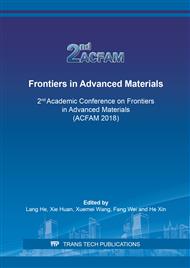[1]
L.F. Hou, Composite solid propellant, first ed., China Aerospace Publishing House, Beijing, (1994).
Google Scholar
[2]
A.M. Pang, Theory and engineering of solid rocket propellant, first ed., China Aerospace Publishing House, Beijing, (2014).
Google Scholar
[3]
S.X. Li, L.M. Zhu, Polyurethane resin, first ed., Jiangsu Science and Technology Publishing House, Nanjing, (1992).
Google Scholar
[4]
M. Celina, Review of polymer oxidation and its relationship with materials performance and lifetime prediction, Polym. Degrad. Stab. 98 (2013) 2419–2429.
DOI: 10.1016/j.polymdegradstab.2013.06.024
Google Scholar
[5]
K. S. Yun, J. B. Park, G. D. Jung, et al. Viscoelastic constitutive modeling of solid propellant with damage, Int. J. Solid. Struct. 80 (2016) 118-127.
DOI: 10.1016/j.ijsolstr.2015.10.028
Google Scholar
[6]
F. Zhao, S. Zhao, W. Bi, et al. Characterization of elastomer networks by NMR parameters-Part I. Sulfur-cured NR networks, Kautsch. Gummi. Kunstst. 10 (2007) 554.
Google Scholar
[7]
F. Zhao, P. Zhang, S. Zhao, et al, Characterization of elastomer networks by NMR parameters-Part II. Influence of accelerators on NR vulcanizates, Kautsch. Gummi. Kunstst. 12 (2007) 685.
Google Scholar
[8]
F. Zhao, P. Zhang, S. Zhao, et al, Characterization of elastomer networks by NMR parameters-Part III. Influence of activators on the network dynamics of NR vulcanizates, Kautsch. Gummi Kunstst. 5 (2008) 224.
Google Scholar
[9]
S. Schlogl, M. L. Trutschel, W. Chasse, et al, Entanglement effects in elastomers: macroscopic vs microscopic properties, Macromol. 47 (2014) 2759-2773.
DOI: 10.1021/ma4026064
Google Scholar
[10]
J.F. Jiang, Q. Gu, L. Sun, et al, Characterization of crosslinked rubber properties with low-field NMR, Chin. Rubber. Ind. 64 (2017) 688-692.
Google Scholar
[11]
X. Sun, A. Isayev, T. Joshi, et al. Molecular mobility of unfilled and carbon-black-filled isoprene rubber: proton NMR transverse relaxation and diffusion, Rubber. Chem. Technol. 80 (2007) 854-872.
DOI: 10.5254/1.3539421
Google Scholar
[12]
V. Litvinov, P. Steeman. EPDM-carbon black interactions and the reinforcement mechanisms, as studied by low-resolution 1H NMR, Macromol. 32 (1999) 8476–8490.
DOI: 10.1021/ma9910080
Google Scholar
[13]
A. Azoug, A. Constantinescu, R. Neviere, et al, Microstructure and deformation mechanisms of a solid propellant using 1H NMR spectroscopy, Fuel. 148 (2015) 39-47.
DOI: 10.1016/j.fuel.2015.01.074
Google Scholar
[14]
S. Thanisararat, R. Detlef, S. Kay, et al, Correlation of crosslink densities using state NMR and conventional techniques in peroxide-crosslinked EPDM rubber, Polym. 56 (2015) 309-317.
DOI: 10.1016/j.polymer.2014.10.057
Google Scholar
[15]
F. F. Wang, H. Chang, L. J. Zhang, Research progress of crosslink density test method and its application in explosives and propellants, Chin. J. Expl. Propell. 39 (2016) 8-12.
Google Scholar
[16]
A. O. Ramona, C. M. M. Pieter, M. L. Victor, et al, Solid-state 1H NMR study on chemical cross-Links, chain entanglements, and network heterogeneity in peroxide-cured EPDM rubbers, Macromol. 40 (2007) 8999-9008.
DOI: 10.1021/ma071015l
Google Scholar
[17]
F. Zhao, W. Bi, S. Zhao, Influence of crosslink density on mechanical properties of natural rubber vulcanizates, J. Macromol. Sci., Part B, 50 (2011) 1460-1469.
DOI: 10.1080/00222348.2010.507453
Google Scholar
[18]
B. Ute, G. Karsten, S. Ulrich, Solid-state NMR on polymers under mechanical stress, AIP Conf. Proc. 1330 (2011) 109-112.
Google Scholar
[19]
P. F. Gao, L. L. Chu, Y. Yang, et al. Comparison of three NMR methods for measuring crosslink density of rubbers, Chin. J. Magn. Reson. 34 (2017) 408-420.
Google Scholar
[20]
National Defense Science and Industry Committee, QJ 916-85: Tensile test method for adiabatic and liner materials in solid rocket motor combustor, Beijing, Standard. (1985).
Google Scholar
[21]
X. G. Zhang., Study on the aging properties and storage life prediction of HTPB propellant, Changsha: National University of Defense Technology, Degree. (2009).
Google Scholar
[22]
J.L. Tian, Z. N. Zhu, J. K. Du, Stress analysis of propellant grain loaded in composite case motor under vertical storage, J. Solid. Rock. Technol. 26 (2003) 34-37.
Google Scholar
[23]
G. Simon, A. Birnstiel, K. H. Schimmel, Network characterization of end-linked poly(dimethyl siloxane) by 1H NMR spin-spin relaxation, Polym. Bul. 21 (1989) 235-241.
DOI: 10.1007/bf00266179
Google Scholar
[24]
Z. D. Wang, L. Z. Xiao, T. Y. Liu, New method for multi-index inversion of NMR relaxation signals and its application, Sci. Chin. (ser G) 33 (2003) 323-332.
Google Scholar
[25]
P. F. Gao, L. L. Chu, Y. Yang, et al. Measurement of crosslinking density of rubbers by analyzing Gaussian-Weighted 1H CPMG relaxation curves, Chin. J. Magn. Reson. 35 (2018) 60-74.
Google Scholar


